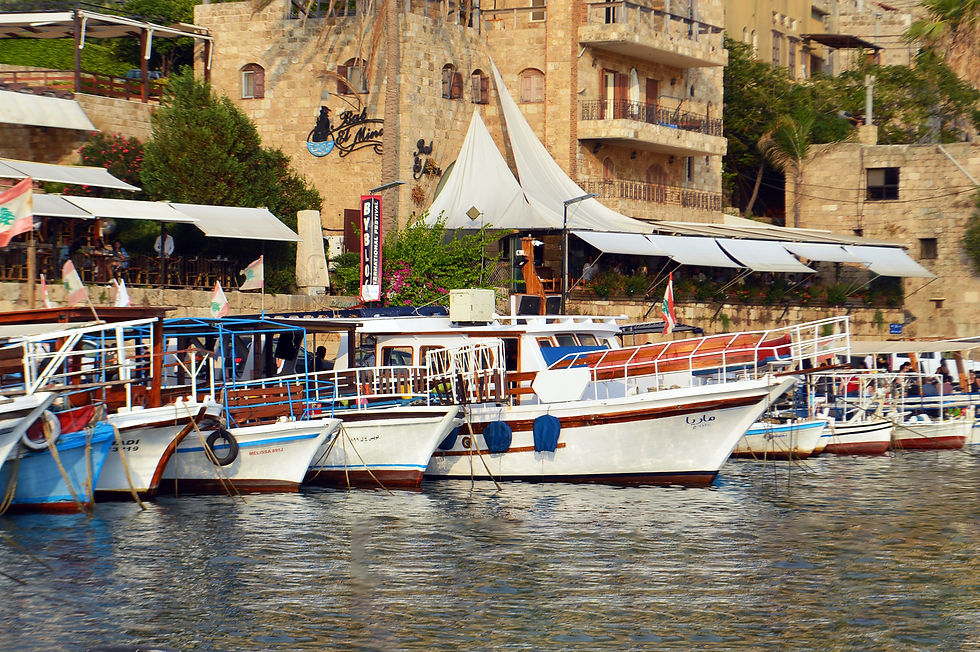Byblos, Vibrant Port City - Bronze Age
- Sylvia Rose

- Jan 10, 2024
- 4 min read
A fascinating center of commerce in the Bronze Age, Byblos has been sporadically inhabited since c. 8800 BCE and continuously since 5000 BCE. With its fertile lands, ocean bounty and gentle climate, Byblos is a paradise for early people.
See also:
Byblos is located on the coast of present day Lebanon. A gleaming object of desire, the city has had Egyptian, Phoenician, Assyrian, Persian, Hellenistic, Roman, Fatimid, Genoese, Mamluk and Ottoman inhabitants.
The Phoenician alphabet is developed in Byblos. While under Phoenician dominion the site is important to the Greeks for papyrus from Egypt, such that byblos means papyrus in Greek. The English word bible comes from the Greek name.
See also:
Byblos is about 42 km (26 mi) north of Beirut, which itself is established c. 3000 BCE. Today Beirut is the largest city in Lebanon.
The first settlement of Byblos is during the Neolithic Period 8800 - 7000 BCE. Neolithic remains of some buildings can still be seen.
See also:
During the 3rd millennium BC, structurally sound houses of similar size, appear, the first signs of a town. From 2600 - 2200 BCE the resident Canaanites are Egyptian control.
According to the Phoenician writer Sanchuniathon, quoted by Philo of Bylos, the city is founded by the Phoenician creator god El. The Greeks idenitify El with their Cronus (Roman Saturn).
See also:
According to historian Will Durant,
“Byblos thought itself the oldest of all cities; the god El had founded it at the beginning of time, and to the end of its history it remained the religious capital of Phoenicia."
Like many cities of this era old Byblos is built atop the settlements of previous generations. This gives a good cross-section of life and subsistence in the town through the centuries.
See also:
At the Neolithic and Chalcolithic (Copper Age) levels flint tools are found, along with some pottery, figurines, arrowheads or sling stones. The levels are:
Early Neolithic (early phase) corresponding to the Pre-Pottery Neolithic B (PPNB) of Jericho, represented by plastered floors and naviform technology, a type of bladework, dated between 8800 and 7000 BCE.
See also:
Early Neolithic (late phase) corresponding to the PNA of Tell es-Sultan (Jericho) IX (also Yarmukian) between 6400 and 5800 BC, represented by pottery, sickle blades, figurines and small points.
Middle Neolithic corresponding to the PNB of Tell es-Sultan (Jericho) VIII and represented by pottery, dated between 5800 and 5300 BCE.
See also:
Late Neolithic corresponding to the Middle Chalcolithic of Beth Shean and represented by pottery, stone vessels, silos, chamber tombs and seals, dated between 5300 and 4500 BCE.
Early Chalcolithic corresponding to the Late Chalcolithic of Ghassulian, represented by jar burials, pierced flint, churn and a violin figurine, dated to between 4500 and 3600 BCE.
In 2800 BCE, a temple is built to honor city Goddess Baalat Gebal (Ba'alat Gubla). She remains tutelary goddess of Byblos through tempestuous millennia of trade, war and progress.
See also:
Late Chalcolithic corresponding to the Early Bronze Age, represented by architecture and cylinder seal impressions, dated to between 3600 and 3100 BCE.
In the Early Neolithic the city site spreads from the hill down into the valley. About twenty houses occupied the space. Some may have been lost to the sea, plundered or just fell down to return to the earth. Houses are rectangular, with plastered floors.
See also:
The Middle Neolithic settlement is smaller, built next to the early site. Pottery becomes more developed, with red washes, varied forms and elaborate decorations. Buildings were less sturdy in construction and floors are not plastered.
In the Late Neolithic building design improves. More highly developed flint tools and a larger variety of pottery is found, with inclusions such as silica, an important component of glass making.
See also:
The Late Chalcolithic features developments of Canaanean blades and fan scrapers. The Canaanean blade is a long, wide blade of stone or flint, primarily found at sites in Israel and Lebanon.
The blade is first manufactured for use in Neolithic Stone Age weapons including javelins and arrowheads. The same technology appears in the later Chalcolithic period in broad sickle blades for harvesting crops. Canaanean blades are also used for threshing grain.
See also:
At this time, adult burials in jars start to appear. The first item of metal, a copper hook, is found. Some ceramics are lined with white plaster after firing.
In the Late Chalcolithic period copper's more common, along with multiple burials in tombs. Jar handles are impressed with marks and designs. The city Goddess of Byblos is Baalat Gebal, or the Mistress, literally "Lady of Byblos".
See also:

Early Bronze Age remains show the development of Byblos combed ware and collections or assemblages of weaponry like knives and spears. In the 20th century BCE, Byblos once more becomes an Egyptian colony. Pharaoh Amenemhet I brings the worship of goddess Baalat Gebal to Egypt.
See also:













